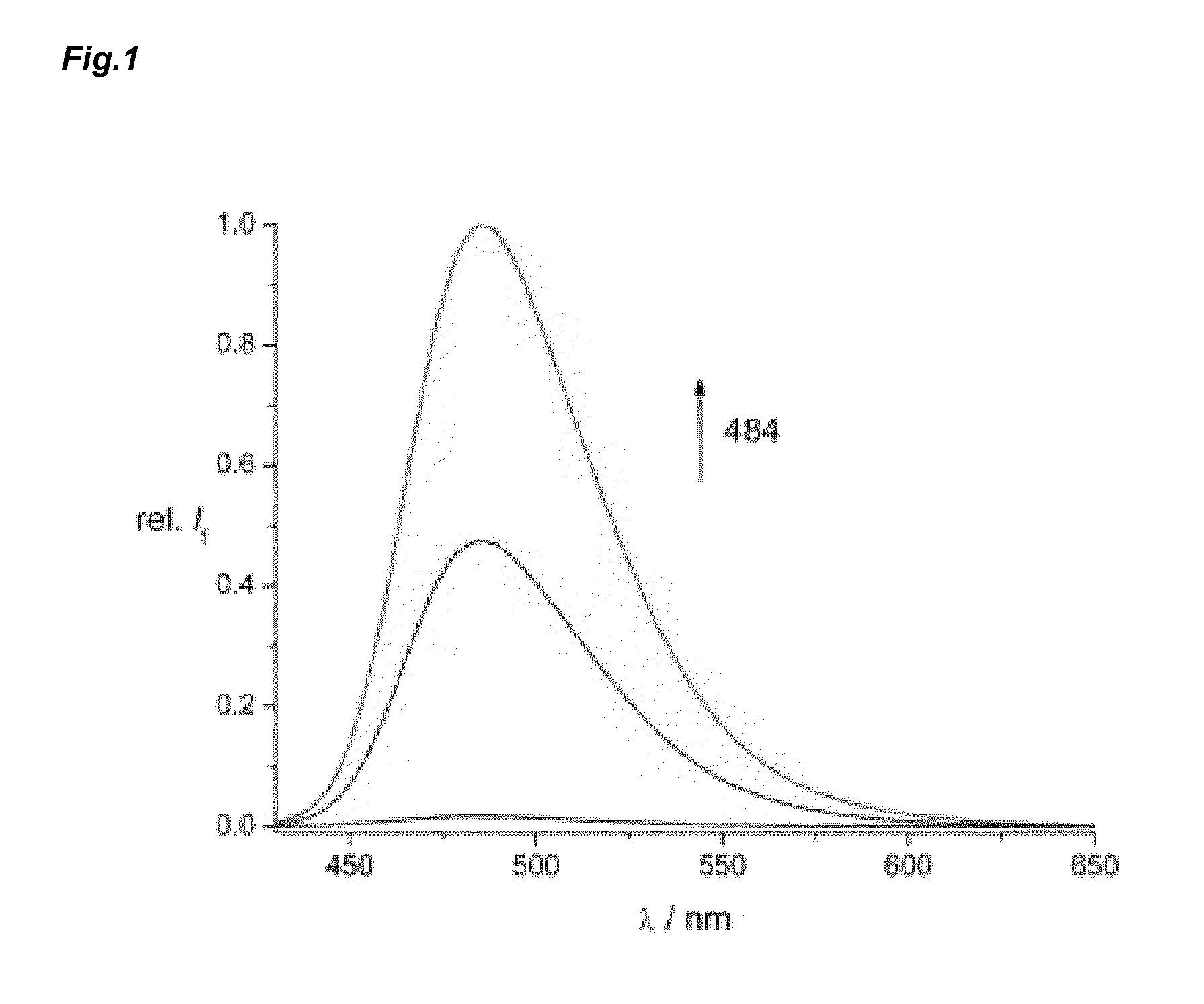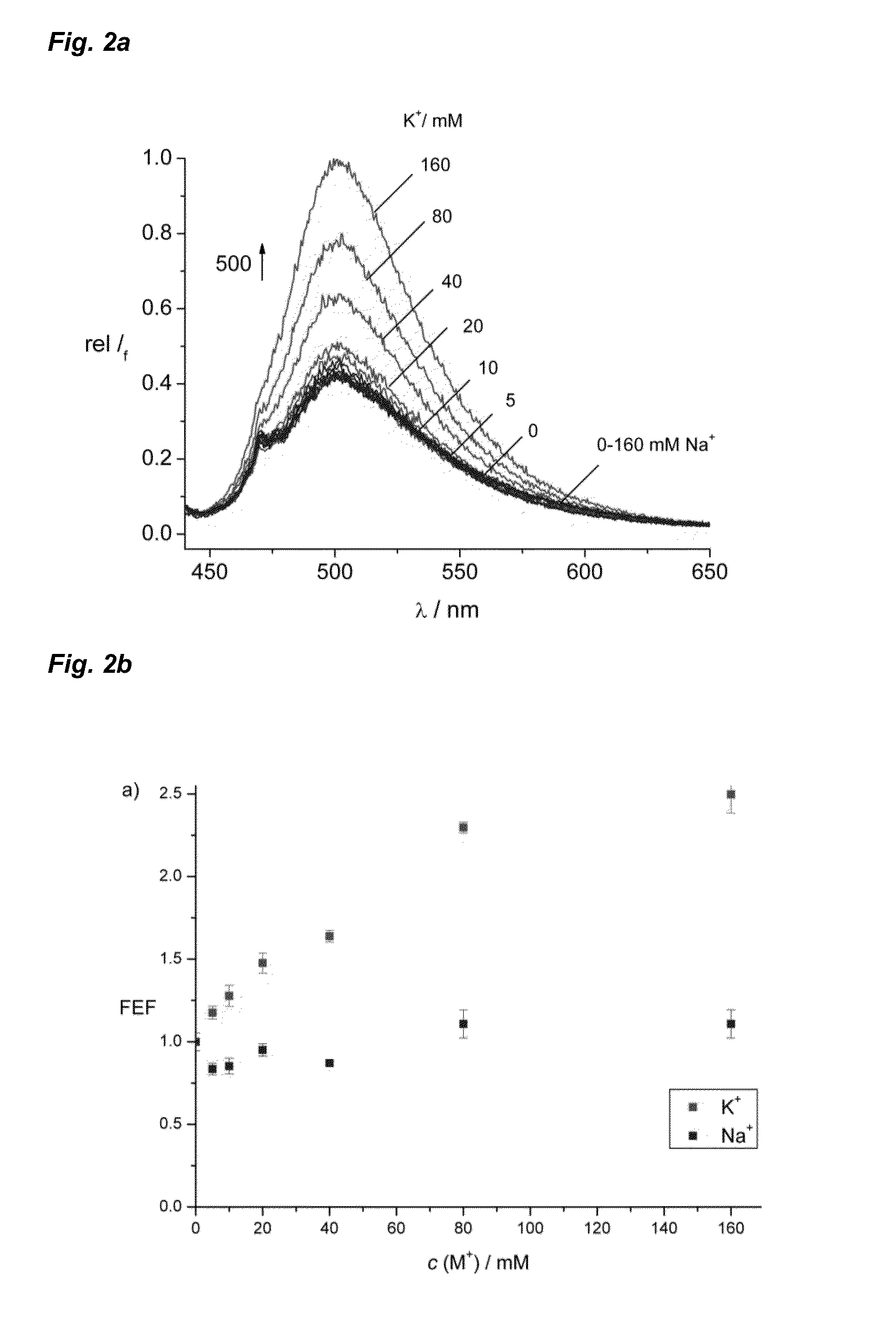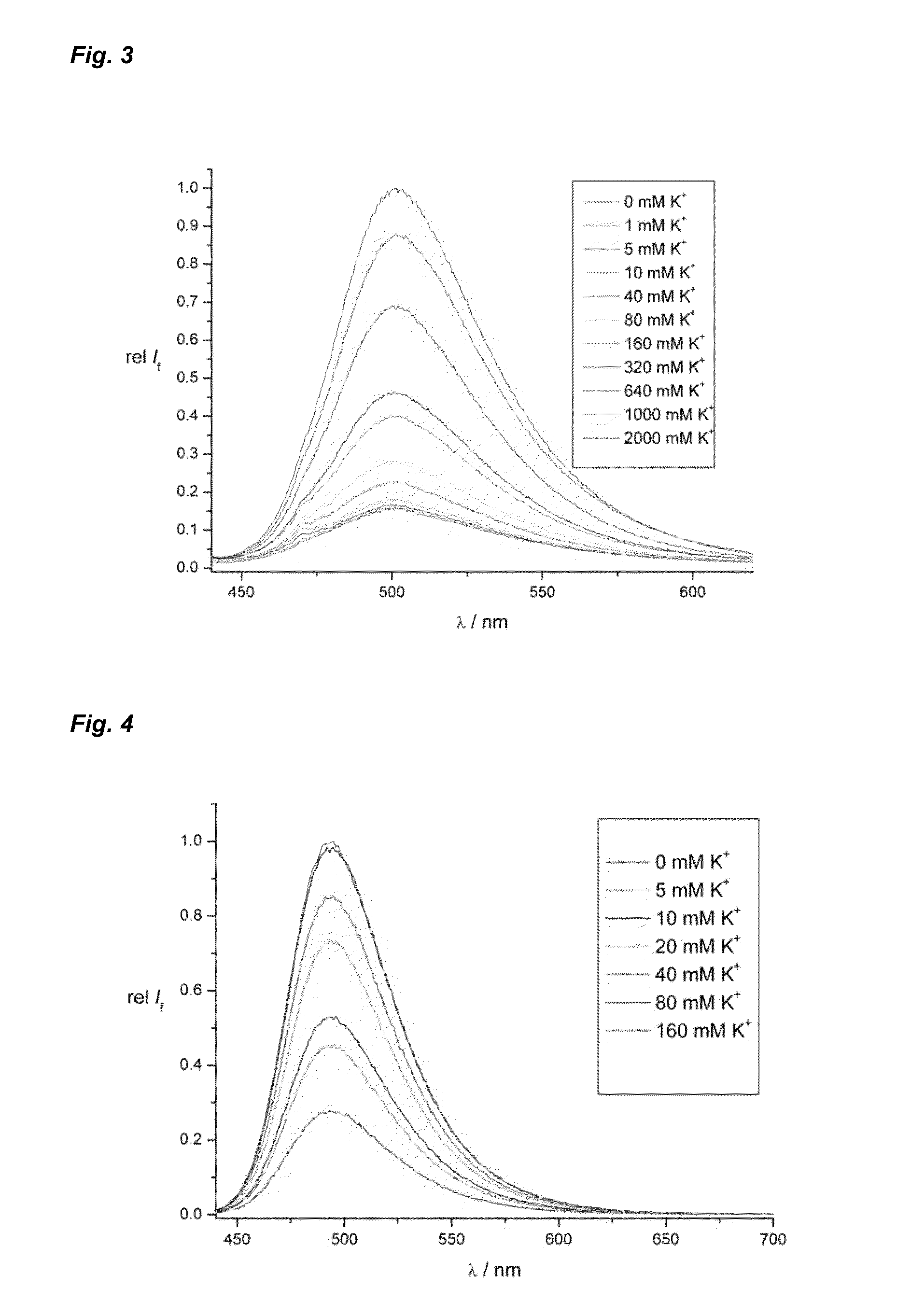Pi-conjugated fluoroionophores and method for determining an alkali ion
a fluoroionophores and ionization technology, applied in the direction of fluorescence/phosphorescence, instruments, group 3/13 element organic compounds, etc., can solve the problems of cations that cannot be measured within a small concentration range, methods that lack sensitivity and selectivity, and compounds and methods known show several disadvantages
- Summary
- Abstract
- Description
- Claims
- Application Information
AI Technical Summary
Benefits of technology
Problems solved by technology
Method used
Image
Examples
example 1
Synthesis of 3-{4-[4-(1,4,7,10,13-pentaoxa-16-azacyclooctadecan-16-yl)phenyl]-1H-1,2,3-triazol-1-yl}-7-(diethylamino)-2H-chromen-2-one (1)
[0222]
[0223]The synthesis followed the general procedure of the CuAAC reaction. Yield: 49%, 1H NMR (CDCl3, 500 MHz): δ=1.23 (t, 6H, J=7.25 Hz), 3.44 (q, 4H, J=7.25 Hz,), 3.64-3.67 (m, 20H), 3.72 (t, 4H, J=5.68 Hz), 6.55 (s, 1H), 6.66 (dd, 1H), 6.75 (d, 2H, J=8.52 Hz), 7.41 (d, 1H, J=8.83 Hz), 7.74 (d, 2H, J=8.83 Hz), 8.15 (s, 1H), 8.38 (s, 1H); 13C (CDCl3, 75 MHz): δ=13.53, 46.05, 52.38, 69.78, 71.89, 98.08, 108.27, 110.91, 112.67, 118.12, 119.22, 119.70, 127.96, 130.95, 135.34, 148.82, 149.06, 152.40, 156.79, 158.02; HRMS (+ESI): m / z calcd. for (M+H)+, 622.32. found, 623.33; UV / Vis (Acetonitrile), λmax (ε)=410 nm (21228 M−1 cm−1), λmax (ε)=288 nm (20211 M−1 cm−1).
example 2
Synthesis of 3-{1-[4-(1,4,7,10,13-pentaoxa-16-azacyclooctadecan-16-yl)phenyl]-1H-1,2,3-triazol-4-yl}-7-(diethylamino)-2H-chromen-2-one (2)
[0224]
[0225]The synthesis followed the general procedure of the CuAAC reaction.
[0226]Yield: 55%, 1H NMR (CDCl3, 600 MHz): δ=1.23 (t, 6H, J=7.25 Hz), 3.44 (q, 4H, J=7.25 Hz,), 3.63-3.67 (m, 20H), 3.72 (t, 4H, J=5.68 Hz), 6.53 (s, 1H), 6.62 (dd, 1H), 6.76 (d, 2H, J=8.48 Hz), 7.41 (d, 1H, J=8.85 Hz), 7.76 (d, 2H, J=8.48 Hz), 8.60 (s, 1H), 8.64 (s, 1H); 13C (CDCl3, 150 MHz): δ=12.54, 44.94, 51.51, 68.58, 70.84, 97.13, 108.83, 109.44, 110.87, 111.93, 120.54, 122.12, 126.56, 129.60, 138.51, 142.06, 148.26, 150.82, 156.11, 160.79; HRMS (+ESI): m / z calcd. for (M+H)+, 622.32. found, 623.35; UV / Vis (Acetonitrile), λmax (ε)=413 nm (40057 M−1 cm−1), λmax (ε)=293 nm (18136 M−1 cm−1).
example 3
Reference Compound
Synthesis of N,N-Diethyl-4-[1-(7-diethylaminocoumarin-3-yl)-1H-1,2,3-triazol-4-yl)]aniline (3)
[0227]
[0228]The synthesis followed the general procedure of the CuAAC reaction. Yield: 60%, 1H NMR (CDCl3, 300 MHz): δ=1.17-1.27 (m, 12H), 3.37-3.50 (m, 8H), 6.57 (s, 1H), 6.68 (dd, 1H), 6.75 (d, 2H, J=8.48 Hz), 7.42 (d, 1H, J=8.85 Hz), 7.76 (d, 2H, J=8.1 Hz), 8.44 (s, 1H), 8.65 (s, 1H), 13C (CDCl3, 75 MHz): δ=12.43, 12.62, 29.69, 44.39, 44.98, 97.08, 107.28, 109.99, 111.80, 117.31, 117.57, 118.61, 127.06, 129.91, 134.15, 147.75, 148.25, 151.41, 155.72, 157.01; HRMS (+ESI): m / z calcd. for (M+H)+, 431.23. found, 432.32; UV / Vis (acetonitrile), λmax (ε)=410 nm (29501 M−1 cm−1), 248 nm (22823 M−1 cm−1).
PUM
| Property | Measurement | Unit |
|---|---|---|
| fluorescence | aaaaa | aaaaa |
| luminescence | aaaaa | aaaaa |
| water-soluble fluorescent | aaaaa | aaaaa |
Abstract
Description
Claims
Application Information
 Login to View More
Login to View More - R&D
- Intellectual Property
- Life Sciences
- Materials
- Tech Scout
- Unparalleled Data Quality
- Higher Quality Content
- 60% Fewer Hallucinations
Browse by: Latest US Patents, China's latest patents, Technical Efficacy Thesaurus, Application Domain, Technology Topic, Popular Technical Reports.
© 2025 PatSnap. All rights reserved.Legal|Privacy policy|Modern Slavery Act Transparency Statement|Sitemap|About US| Contact US: help@patsnap.com



